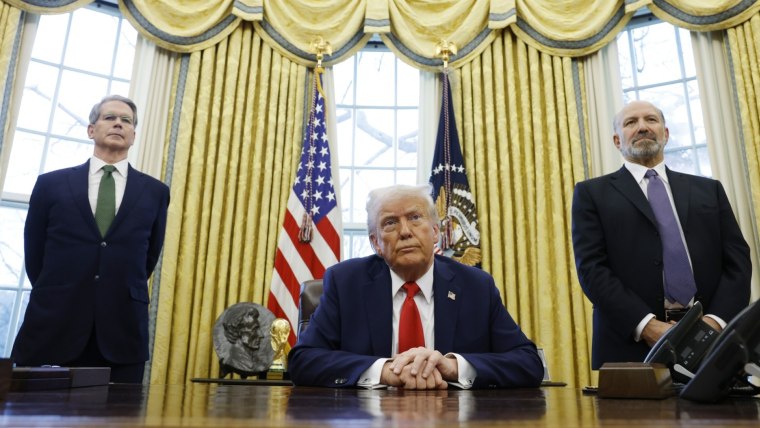UPDATE (Feb. 27, 2025, 8:10 a.m. ET): NBC News reports that early on Thursday, Andrew and Tristan Tate "left for the United States after a travel ban on them was lifted, according to Romanian prosecutors."
Last week, four women who accused British-American influencer and podcaster Andrew Tate of sexual abuse implored the U.S. not to interfere with Tate’s case in Romania, where he and his brother Tristan Tate are facing charges of human trafficking and a money laundering investigation.
The plea from the women came after the Financial Times, citing three people familiar with the matter, reported that U.S. officials, including Trump special envoy Richard Grennell, spoke with the Romanian government about the case against the self-described misogynist podcasters. The Tates have been held in the country as they face numerous charges including rape as well as charges of forming a criminal group to sexually exploit women (they have denied any wrongdoing). Grenell told the FT he had had “no substantive conversation” with Romania’s foreign minister and said, “I support the Tate brothers as evident by my publicly available tweets.”
If you haven’t spent the past decade glued to social platforms and smartphone screens, you get a pass for being a bit confused.
Seeing members of the Trump administration speak so favorably of the disgraced podcaster, who remains hugely influential in male dominated alt-right internet culture, shows how the administration has enmeshed itself with influential figure heads of a dangerous hyper-masculine culture. When Paul Ingrassia, a lawyer representing Tate, was made the White House liaison for the Department of Justice, it was another telling example of the current wave of misogyny-fueled politics surging through the upper echelons of the administration. It all seems to feed into a trend that Axios recently dubbed “masculinist maximalism,” which is a bit of a mouthful considering what we’re talking about here is fairly simple: Conservative men are in charge of the country and they are working to remake it in their own image.
If you haven’t spent the past decade glued to social platforms and smartphone screens, you get a pass for being a bit confused. The ideology many inside of Trump World currently subscribe to, one that has become convinced that there is a global cultural war against men, is one that has been congealing on the fringe corners of the web, led by loathsome bloggers, shameless influencers, violent incels, and genuine extremists. And while there are many contours to it, the guiding philosophy is fairly simple.
In the 2010s, a growing number of male users, incubating in extremist online content, bought into and perpetuated the belief that almost every aspect of modern life was, essentially, for women and, thus, bad. And now they want to turn back the clock, socially and politically, until they feel as if men are finally back in charge.

Now, this is, obviously, ridiculous. The 2010s did see an influx in big, successful progressive movements — gay marriage legalization, Black Lives Matter, the Me Too movement — and there were genuine strides made to make both the government and businesses more inclusive of women, queer people, and people of color. But as evidenced by the dozens of “canceled” victims of the culture war that quickly bounced back with new companies, new deals, and Netflix specials, white men in America were never truly in danger of losing their power.
But the story that’s been told online has been much different.
Fringe spaces like 4chan and Reddit, along with more mainstream platforms like YouTube and the website formerly known as Twitter began to fill up with men eager to convince other men that feminine modernity was the reason they couldn’t get a girlfriend, couldn’t get a job, couldn’t do whatever they wanted whenever they wanted. These spaces have been responsible for dozens of harassment campaigns against prominent women for years. Political online movements like Gamergate and Comicsgate targeted women in video games and comics. But they’ve also opened the door to a general online war against any and all women. One of the big rallying cries among some Trump supporters after the election was, “your body, my choice.”
We’ve entered a world where the very concept of being a “man” has become enmeshed in reactionary right-wing politics.
During President Donald Trump’s first presidential campaign, Republican strategists like Steve Bannon shrewdly tapped into these spheres of influence. And like a snowball turning into an avalanche, during the first Trump administration, these obscure digital cults began to coalesce into something larger. And with that came a new wave of influencers preaching the wonders of hyper masculinity. Podcasters like Tate and Joe Rogan, YouTubers like the NELK Boys, and digital media brands like Barstool Sports have gone all in on masculine digital culture and, increasingly, Trumpism. There was a whole section of white, male online influencers invited to Trump’s inauguration last month. And this rise of new masculinity poses a serious existential problem for Democrats that extends far beyond Trump.
We’ve entered a world where the very concept of being a “man” has become enmeshed in reactionary right-wing politics. Last November, outlets all over the country asked if “the left needed a Joe Rogan,” but that doesn’t fully capture the problem. What we should be asking is “how do we bring men to the left,” full stop.
No real answers have been offered on that front, leaving the rest of society more and more vulnerable to the Rogans and Tates and other purveyors of masculinist maximalism of the internet.
